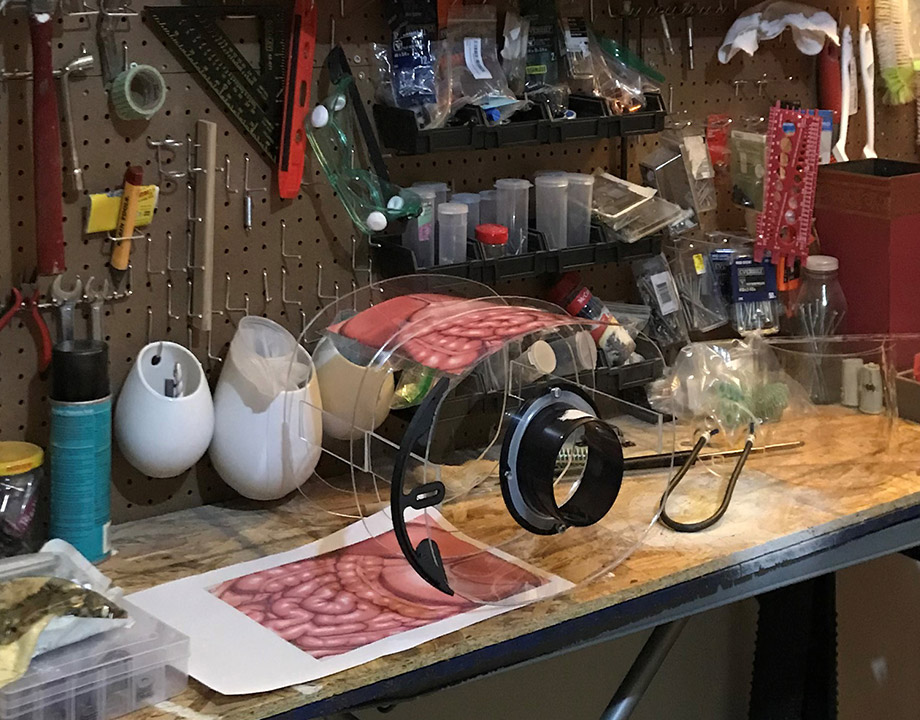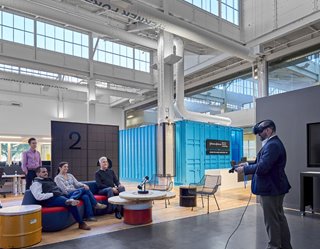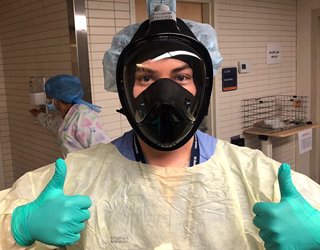Innovation in the Time of COVID-19
Innovation in the Time of COVID-19


Engineers in labs have raced to find ways to work on prototypes at home. Shown here, engineer Megan Greenwood’s ironing board workbench.
In the first few months of 2020, a period that Peter Adamczyk now refers to as “a lifetime ago,” University of Wisconsin’s Biomechatronics, Assistive Devices, Gait Engineering and Rehabilitation (BADGER) Lab was working hard on redesigning a sensor-driven adaptive prosthetic foot. Adamczyk, who heads the lab, was excited about their progress, and how close they were to building a prototype from their CAD designs. Then, in March, as the COVID-19 virus started to spread across the country, the University closed its doors. Laboratories and buildings on campus were locked, and students were sent home. Work ground to a halt.
“The design team was at the point where I was about to say, ‘Good job. Go build it,’” Adamczyk said. “Normally, that means sending them to the building next door to the shop to create a prototype. But then they closed, everything down. It’s a challenge to produce anything——or test what a prototype can do—without access to the lab.”
Around the same time, approximately 1000 miles south of Madison, engineers at Texas Medical Center’s world-renowned Center for Device Innovation (CDI) in Houston, also found themselves subject to a city-wide stay-at-home order. This posed a huge challenge for the team. The organization’s physical workspace—a former cookie factory—was designed for the kind in-person collaboration and quick builds that foster the organization’s tried and true “fail fast” innovation techniques, said Matt Kuhn, a project leader with the Houston-based lab.
Listen to the Podcast: Digital Solutions During the Coronavirus Pandemic
“We work in a 25,000-square-foot maker space with every piece of equipment you could ever possibly need to do medical device prototyping,” Kuhn explained. “I work with an incredible team of engineers. We are always bouncing ideas off one another. Having the ability to do that, as well as to just hop into the lab to build and test out a new concept, means the speed at which we can ideate and test new ideas is incredible. When all this happened, we weren’t sure how that would translate to working from home.”
In the age of COVID-19, mechanical and other engineers who were accustomed to collaborating in multidisciplinary teams while working with physical prototypes now find themselves working remotely, often with nothing more than a curious mind and a laptop computer. But they are discovering creative new ways to continue working on new designs while they shelter in place—and developing skills that may help them to better foster innovation once they return to their workplaces when this crisis ends.
At first, Jonah Myerberg, Chief Technology Officer of Desktop Metal, a Massachusetts-based company that designs 3D metal printers, said the idea of not being able to work with his team was of great concern.
“We spent so much time in the lab working together, running experiments, testing ideas, and brainstorming how to improve designs,” he said. “In the beginning, I just couldn’t see being able to do a lot of that kind of work while quarantined. But there are a lot of tools out there that can help you find ways to collaborate and even build things. You just have to be open to trying them.”
Certainly, mechanical engineers across the globe are now being asked to ramp up to speed on a variety of different online collaboration and videoconferencing platforms as they work from home. Adamczyk said that he and his students are not only doing a lot of CAD work from afar but are also relying on a variety of different online tools to continue design collaborations. As they started working this way over the last six weeks, he has found it has changed where his engineers focus their efforts.
“One of the biggest challenges is trying to figure out ways to give appropriate feedback on a design,” he said. “A lot of my students took home some kind of prototype and are working on it at home. They try to convey its performance to me by video or performance recordings. We are essentially trying to find a substitute for physical objects that we can convey in cyberspace, which is not easy.
“But, that said, it has given us an opportunity to refocus on different aspects of design, like refactoring the control program or adding some new functions. These are things we probably wouldn’t have gotten to if we were racing ahead on the physical design.”
CDI’s Kuhn agreed and said his team has taken a step back and taken time to “nurture” things that may have fallen by the wayside in their traditional “fail fast” rush to prototype.
Learn more about how COVID-19 May Change the Engineering Workforce
“Maybe it’s cleaning up CAD models or refining those little things we didn’t think we had time for before,” he said. “Maybe it’s time to look at documentation. Maybe it’s checking in with other engineers about how they solved a certain problem. Having this time at home has shifted my approach to innovation. Instead of rushing to create a prototype, I’m now spending more time taking a research perspective, and looking at different ways we might approach a particular design.”
Other engineers, like Kuhn’s colleague, Megan Greenwood, a senior research and design engineer at CDI, are looking for ways to build physical prototypes outside the lab. She has created a makeshift garage prototyping space, complete with a workbench made of medium-density fiberboard on top of an ironing board, along with power drills and “just about every hand tool you can imagine,” she said.
“I can’t machine a part on a computer numerical control (CNC) mill or cut something on the laser cutter,” Greenwood said. “But there’s still a lot of value in making something tangible, so you can put your hands on it and think through the design that way. Even a really basic prototype made up of household items is better than nothing. Sometimes you just have to get creative.”
This is also a great time to outsource prototypes, Desktop Metal’s Myerberg added. There are plenty of outfits that can build something from a CAD design and ship it to the customer directly. His team at Desktop Metal, for example, recently launched a website that prints 3D metal components for mission-critical COVID-19 applications for free.
“There are some high-integrated design teams out there who are meeting on Zoom or Slack every day, organizing different pieces of the puzzle, and then need to figure out how to get those pieces together into a build,” he said. “We opened up our doors, saying we will print things for companies who are working on ventilators or other projects that are essential to the medical needs of the pandemic. You never know where innovation is going to come from. We want to help people create those solutions that will really make a difference.”
When asked what lessons learned may help continue foster innovation once stay-at-home restrictions are lifted, and engineers can return to the lab, Kuhn said he has appreciated the ability to communicate with engineers outside CDI.
“I’ve been reaching out to researchers and academic labs to ask different questions, and it’s really facilitated a lot of great conversations that have helped how I’m thinking about design,” he said. “I probably wouldn’t have done that kind of branching out and networking without this—and I think it will be helpful to keep doing this even after we go back to the office.”
Adamczyk said he did not fully appreciate the value of online collaboration tools before the pandemic—and said he believes their use will not only make collaborative projects easier across the lab but also across institutions.
“If you use an online whiteboard or note-taking platform while you are discussing something with your team remotely, those thoughts don’t disappear into someone’s notebook. There’s a record you can go back to in the future,” he said. “Also, now that everyone is using these tools, you can really look outside your lab for expertise to find the right person for the right job as you are working on projects. I think it will help to facilitate cross-country and international projects.”
Related Manufacturing Blog: Connect with Engineers via the Open COVID-19 Community
Myerberg said he is confident that the pandemic, and the demands it will make of engineers both personally and professionally, will fuel engineering ingenuity in ways we cannot yet imagine. In fact, the old saying, “necessity is the mother of invention,” has never felt more apt.
“You never know where innovation is going to come from—or who it is going to come from,” he said. “But, as engineers, we’re used to working within certain constraints. We always find a way to figure it out. There’s no reason why we can’t figure it out in this situation, too.”
Kayt Sukel is a freelance writer and author in Houston, Tex.
“The design team was at the point where I was about to say, ‘Good job. Go build it,’” Adamczyk said. “Normally, that means sending them to the building next door to the shop to create a prototype. But then they closed, everything down. It’s a challenge to produce anything——or test what a prototype can do—without access to the lab.”
Around the same time, approximately 1000 miles south of Madison, engineers at Texas Medical Center’s world-renowned Center for Device Innovation (CDI) in Houston, also found themselves subject to a city-wide stay-at-home order. This posed a huge challenge for the team. The organization’s physical workspace—a former cookie factory—was designed for the kind in-person collaboration and quick builds that foster the organization’s tried and true “fail fast” innovation techniques, said Matt Kuhn, a project leader with the Houston-based lab.
Listen to the Podcast: Digital Solutions During the Coronavirus Pandemic
“We work in a 25,000-square-foot maker space with every piece of equipment you could ever possibly need to do medical device prototyping,” Kuhn explained. “I work with an incredible team of engineers. We are always bouncing ideas off one another. Having the ability to do that, as well as to just hop into the lab to build and test out a new concept, means the speed at which we can ideate and test new ideas is incredible. When all this happened, we weren’t sure how that would translate to working from home.”
In the age of COVID-19, mechanical and other engineers who were accustomed to collaborating in multidisciplinary teams while working with physical prototypes now find themselves working remotely, often with nothing more than a curious mind and a laptop computer. But they are discovering creative new ways to continue working on new designs while they shelter in place—and developing skills that may help them to better foster innovation once they return to their workplaces when this crisis ends.
Adaptation and Innovation
At first, Jonah Myerberg, Chief Technology Officer of Desktop Metal, a Massachusetts-based company that designs 3D metal printers, said the idea of not being able to work with his team was of great concern.
“We spent so much time in the lab working together, running experiments, testing ideas, and brainstorming how to improve designs,” he said. “In the beginning, I just couldn’t see being able to do a lot of that kind of work while quarantined. But there are a lot of tools out there that can help you find ways to collaborate and even build things. You just have to be open to trying them.”
Certainly, mechanical engineers across the globe are now being asked to ramp up to speed on a variety of different online collaboration and videoconferencing platforms as they work from home. Adamczyk said that he and his students are not only doing a lot of CAD work from afar but are also relying on a variety of different online tools to continue design collaborations. As they started working this way over the last six weeks, he has found it has changed where his engineers focus their efforts.
“One of the biggest challenges is trying to figure out ways to give appropriate feedback on a design,” he said. “A lot of my students took home some kind of prototype and are working on it at home. They try to convey its performance to me by video or performance recordings. We are essentially trying to find a substitute for physical objects that we can convey in cyberspace, which is not easy.
“But, that said, it has given us an opportunity to refocus on different aspects of design, like refactoring the control program or adding some new functions. These are things we probably wouldn’t have gotten to if we were racing ahead on the physical design.”
CDI’s Kuhn agreed and said his team has taken a step back and taken time to “nurture” things that may have fallen by the wayside in their traditional “fail fast” rush to prototype.
Learn more about how COVID-19 May Change the Engineering Workforce
“Maybe it’s cleaning up CAD models or refining those little things we didn’t think we had time for before,” he said. “Maybe it’s time to look at documentation. Maybe it’s checking in with other engineers about how they solved a certain problem. Having this time at home has shifted my approach to innovation. Instead of rushing to create a prototype, I’m now spending more time taking a research perspective, and looking at different ways we might approach a particular design.”
Other engineers, like Kuhn’s colleague, Megan Greenwood, a senior research and design engineer at CDI, are looking for ways to build physical prototypes outside the lab. She has created a makeshift garage prototyping space, complete with a workbench made of medium-density fiberboard on top of an ironing board, along with power drills and “just about every hand tool you can imagine,” she said.
“I can’t machine a part on a computer numerical control (CNC) mill or cut something on the laser cutter,” Greenwood said. “But there’s still a lot of value in making something tangible, so you can put your hands on it and think through the design that way. Even a really basic prototype made up of household items is better than nothing. Sometimes you just have to get creative.”
This is also a great time to outsource prototypes, Desktop Metal’s Myerberg added. There are plenty of outfits that can build something from a CAD design and ship it to the customer directly. His team at Desktop Metal, for example, recently launched a website that prints 3D metal components for mission-critical COVID-19 applications for free.
“There are some high-integrated design teams out there who are meeting on Zoom or Slack every day, organizing different pieces of the puzzle, and then need to figure out how to get those pieces together into a build,” he said. “We opened up our doors, saying we will print things for companies who are working on ventilators or other projects that are essential to the medical needs of the pandemic. You never know where innovation is going to come from. We want to help people create those solutions that will really make a difference.”
Tips from the Trenches
When asked what lessons learned may help continue foster innovation once stay-at-home restrictions are lifted, and engineers can return to the lab, Kuhn said he has appreciated the ability to communicate with engineers outside CDI.
“I’ve been reaching out to researchers and academic labs to ask different questions, and it’s really facilitated a lot of great conversations that have helped how I’m thinking about design,” he said. “I probably wouldn’t have done that kind of branching out and networking without this—and I think it will be helpful to keep doing this even after we go back to the office.”
Adamczyk said he did not fully appreciate the value of online collaboration tools before the pandemic—and said he believes their use will not only make collaborative projects easier across the lab but also across institutions.
“If you use an online whiteboard or note-taking platform while you are discussing something with your team remotely, those thoughts don’t disappear into someone’s notebook. There’s a record you can go back to in the future,” he said. “Also, now that everyone is using these tools, you can really look outside your lab for expertise to find the right person for the right job as you are working on projects. I think it will help to facilitate cross-country and international projects.”
Related Manufacturing Blog: Connect with Engineers via the Open COVID-19 Community
Myerberg said he is confident that the pandemic, and the demands it will make of engineers both personally and professionally, will fuel engineering ingenuity in ways we cannot yet imagine. In fact, the old saying, “necessity is the mother of invention,” has never felt more apt.
“You never know where innovation is going to come from—or who it is going to come from,” he said. “But, as engineers, we’re used to working within certain constraints. We always find a way to figure it out. There’s no reason why we can’t figure it out in this situation, too.”
Kayt Sukel is a freelance writer and author in Houston, Tex.







